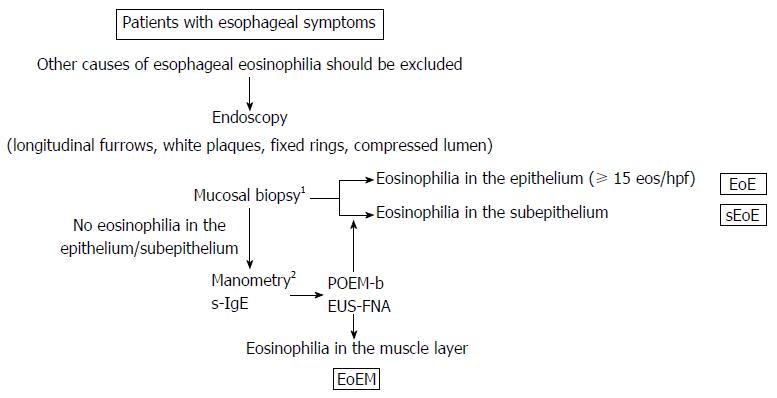Copyright
©The Author(s) 2017.
World J Gastroenterol. Apr 7, 2017; 23(13): 2414-2423
Published online Apr 7, 2017. doi: 10.3748/wjg.v23.i13.2414
Published online Apr 7, 2017. doi: 10.3748/wjg.v23.i13.2414
Figure 6 Proposed diagnostic criteria for eosinophilic gastrointestinal disorders in the esophagus.
Patients with esophageal symptoms receive endoscopy. 1Mucosal biopsy should include a sufficient amount of subepithelium together with epithelium to allow subepithelial eosinophilia to be identified. If no or low degree of eosinophilia is seen in the epithelium/subepithelium but manometry shows abnormal peristalsis and elevated serum immunoglobulin E (s-IgE) level, peroral esophageal muscle biopsy (POEM-b) or endoscopic ultrasound-guided fine needle aspiration (EUS-FNA) is recommended to detect eosinophilia in deeper layers. 2Manometry findings and s-IgE levels are variable, careful follow-up is recommended even if the findings are normal initially; Other alternative causes of esophageal symptoms should be ruled out.
- Citation: Sato H, Nakajima N, Takahashi K, Hasegawa G, Mizuno KI, Hashimoto S, Ikarashi S, Hayashi K, Honda Y, Yokoyama J, Sato Y, Terai S. Proposed criteria to differentiate heterogeneous eosinophilic gastrointestinal disorders of the esophagus, including eosinophilic esophageal myositis. World J Gastroenterol 2017; 23(13): 2414-2423
- URL: https://www.wjgnet.com/1007-9327/full/v23/i13/2414.htm
- DOI: https://dx.doi.org/10.3748/wjg.v23.i13.2414









